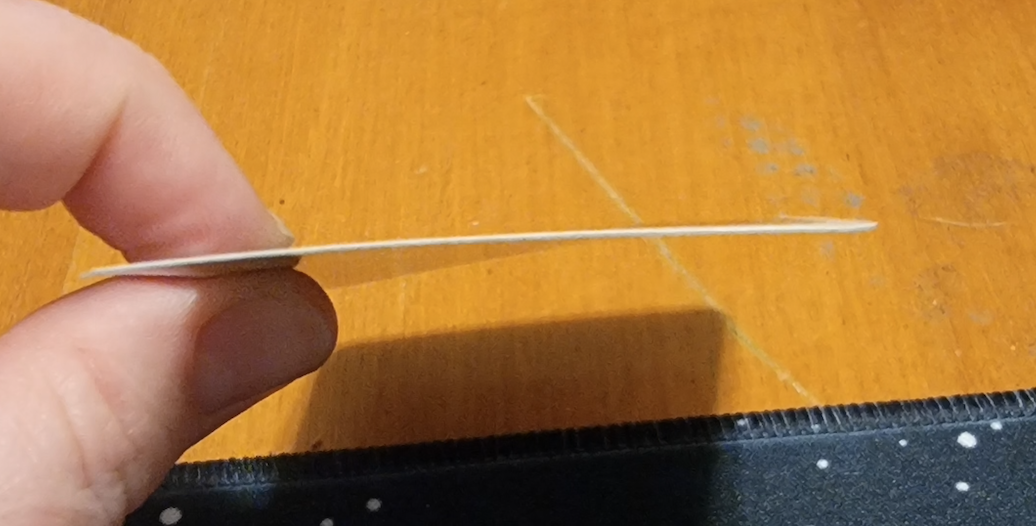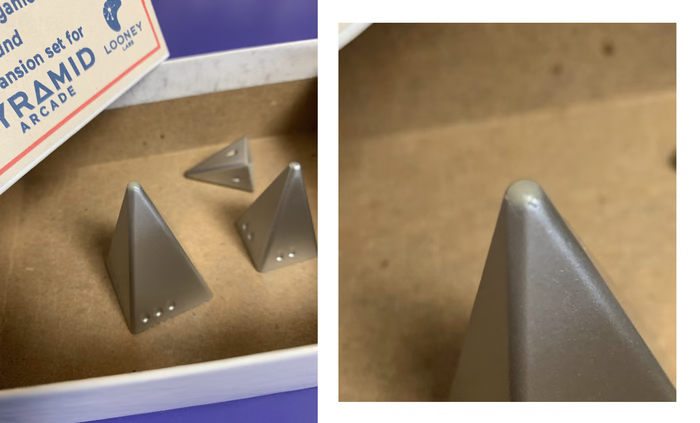If you don’t see your question answered among these, please email us at:
FAQ@looneylabs.com
- Q: We just opened our new deck, and all the cards are bent!
- Q: What size are the squares on the Chessboard Bandana?
- Q: You make some of your games in China now. How do you ensure that they are ethically made?
- Q: I bought one of your games, and the box doesn’t feel very solid. Do you think it might be a low-quality counterfeit?
- Q: Do you have blank boxes, or can I print out my own?
- Q: Is there a “formula” for creating a new version of Fluxx? How many of each card type, which “generic” cards to include, that sort of thing?
- Q: What do I need to make a fully-custom Fluxx version? (Just for myself, of course)
- Q: Can you send me high-resolution art for one of your games so I can make custom cards that look perfect, and have them printed at a printer?
- Q: Do the ELBS cut from the Deluxe black and white Volcano Board fit into the all-white Pyramid Arcade Volcano Board?
- Q: How durable is the silver coating on the silver pyramids?
- Q: What’s with this sticky residue on the bottoms of the Silver ‘Mids?
- Q: Why doesn’t this promo card/expansion pack match my deck perfectly?
- Q: Is there a good container to fit a double-sized combined Fluxx deck or an UberChrono deck?
- Q: What size are the new Zendo pieces, relative to regular pyramids? Would they fit in a Volcano board?
- Q: What are the differences between the pyramids from different generations, like early ones vs. the later Pyramid Arcade ones?
- Q: What are the dimensions of Looney Pyramids?
- Q: Can I buy your pyramids in custom quantities?
- Q: Can I use your pyramids in my game?
- Q: The pegs in don’t stay in well for the original printing of Fluxx: the Board Game. What can I do about that?
- Q: Why are some of your games in hang-tab boxes, and some in two-part lidded boxes?
- Q: What can we do about certain card types becoming overworn (Goals in Aquarius, Choice cards in Choose One)?
- Q: What size are the decks of cards in Pyramid Arcade? Where can I get sleeves for them?
- Q: Who prints your promo cards, and is it done in the US?
- Q: What size are Fluxx cards? (or any of your other games?) Where can I get sleeves for them?
- Q: What exactly is in the “Mystery Bag Of Warehouse Swag”?
- Q: I just bought a new Fluxx, and the cardstock feels really cheap and flimsy! What’s up with that?
- Q: Is there any way to keep those peel-off promo cards from sticking to the other cards?
- Q: How can I use my printer to make my Fluxx Blanxx come out really nice?
- Q: Hey, do you still have any more of those tubes that pyramids used to be sold in?
Q: We just opened our new deck, and all the cards are bent!
A: This slight curvature is not uncommon for new cards fresh off the rollers from the printer. It typically goes away with use, and should not interfere with shuffling, but if it’s bothering you, you can take the cards in small stacks of 10-15 cards and bend them gently in the opposite direction to correct.
This should not affect the playability of the deck in any way, in fact it’s actually quite difficult to pick perfectly flat cards up off a table, so the slight bend is less of a disadvantage than you might think.
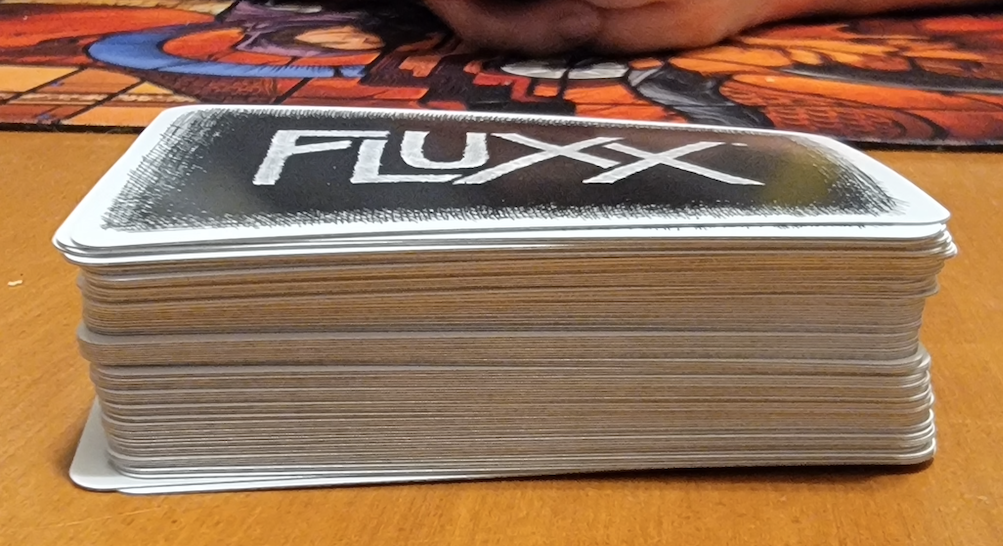
Q: What size are the squares on the Chessboard Bandana?
A: The squares are 1.75″ on a side. This is a teeny bit shorter than a large pyramid on its side, but should not interfere with most games. These were designed to be used with pyramids, so they shouldn’t be so far off that they are a problem.
Q: You make some of your games in China now. How do you ensure that they are ethically made?
A: This was a very important consideration when we were first thinking about whether to manufacture there at all.
The companies we partner with are vetted by an association called the International Council of Toy Industries (ICTI). They created their Ethical Supply Chain Program (ESCP) to help toy companies all over the world select responsible manufacturers.
You can look up suppliers by name to see their current status.
Our card games are made by a company called LongPack. To make our pyramid games, we contract with a company called Grand Prix International, and the Chinese company they work with for those is called Foshan Hofat Paper Products. Both are current with their certifications!
Q: I bought one of your games, and the box doesn’t feel very solid. Do you think it might be a low-quality counterfeit?
A: It is very unlikely to be a counterfeit. Our boxes do feel a little “squishy” when compared to most two-part game boxes, because of differences in they way they’re made.
The most common type of two-part lidded box is called a setup box. For most board games, the top and bottom are made with cardboard which is then wrapped with a separate lighter-weight glossy-printed cover, which performs the double-duty of holding the box together at the seams, and providing the attractive art. The cardboard has to be cut to shape, scored and folded into position, and the wrap needs to be printed, cut, glued and wrapped on.
The way our boxes are made, each part (the lid part, and the bottom part) is made of a single piece of cardboard, printed on one side, and folded up. This means the process of making them involves just printing them, cutting them, and folding them together (and sometimes gluing them). This is much less expensive to make, since there’s just one thing to print and cut, and the assembly is more like cardboard origami than cardboard carpentry.
In order to be folded, of course, the material in our boxes has to be a bit lighter-weight than the kind used in a standard setup box, which results in our box having a more flexible feel when you squeeze it in your hand.
In addition to this box being a bit cheaper to produce, it also makes it possible for us to gang run our print runs together, making it possible to make smaller runs at a much more affordable price. We have published 50+ games in this exact size of little boxes, and we can mix and match any of them on a reprint run in quantities as low as 1000 copies!
Q: Do you have blank boxes, or can I print out my own?
A: We do occasionally make blank versions of some of our boxes. The Bigger Blanker Box is an example which has been around intermittently, when we have made games in that size (Time Breaker, Pyramid Quartet, Chrono-Trek).
But, long ago, one of our friend/fans, Elliot Evans (AKA Eeyore), created a number of card box templates, and another, Craig Forbes, made a neato custom-generation app. Here is Eeyore’s box page.
There’s a link there to Craig’s any-size-tuckbox generator, as well as a template for our standard side-by-side box. Rather than linking to each template directly from here, it’s good to check out that main page, as it also has some good tips on how to go about printing any of the boxes. Remember when he talks about “the printed side” he means the side with the cut and fold lines, and when he talks about laminating it, he’s talking about laminating the outside.
Q: Is there a “formula” for creating a new version of Fluxx? How many of each card type, which “generic” cards to include, that sort of thing?
…Just for fun, I want to try designing my own deck – strictly for personal use.
A: The most basic formula is simply 25% of each of the 4 card types, but Fluxx is a very flexible game engine and you can push any of those numbers as needed. Indeed, it usually ends up being closer to 20 Keepers and 30 Goals. Just to give you an idea of the range of variability for the numbers, you can check out the card ratios for every version of Fluxx on the right side of this chart.
If you decide to include Creepers, they will take the place of some of your Keepers. But be careful about Creepers… don’t add too many, and don’t use them at all unless the subject matter really demands it. If so, be sure to include plenty of ways of to get rid of them.
Always use all of the usual Draw and Play rules, and at least a couple of Hand Limits (they may not seem fun but they are important for preventing out-of-control hand growth). Start with basically all of the Actions from basic Fluxx, then replace whichever of those you think don’t fit and replace them with as many on-theme new Actions and Rules as you can imagine.
As for the Keepers and Goals, the important thing there is to make sure every Keeper has at least 2 uses, i.e. it appears on at least 2 Goals. Obviously, the more uses the better.
We call the most useful Keeper in the set the Chocolate (since that’s the one most used in the original non-themed versions). If your theme has a main character or primary focus, such as Dorothy in Oz Fluxx or Alice in Wonderland Fluxx, then that Keeper should be your Chocolate. Have fun!
For some more practical tips about designing your own custom Fluxx deck see: Q: What do I need to make a fully-custom Fluxx version?…
Q: What do I need to make a fully-custom Fluxx version? (Just for myself, of course)
…Can you send me Blanxx files so I can create the whole deck on my computer?
A: No, sorry, we don’t send out files for our cards, not even the Blanxx. It’s simply not a good idea for us to do so. Yes, it’s expensive to make a full deck with Blanxx, there’s just no getting around that fact. If you were going to create every card from scratch, even the basic Draw, Play, and Limit Rules, you’d need about 20 packs of Blanxx (since there’s only 1 blank Rule card and 1 blank Action in each packet). That would cost you $100. (Though, at least you’d get a 10% discount on your order.)
For this reason, we suggest picking one of our (cheaper, non-licensed) decks as a “base set” and using the “universal” Rules and common Actions as a starting point. Frankly, it’s VERY difficult to think of new themed Actions and Rules (though you may want to use existing functionality, and re-name them. That’s totally valid.)
Then get enough Blanxx for your Keepers (there are 2 Keepers and 3 Goals in each Blanxx pack) so maybe you’d need… 10-12 Blanxx packs? So this cuts your costs down to:
Base deck: $20
10-12 Blanxx: $50-$60
That’s $70-$80, which is still really expensive, but still saves you up to $30.
Finally, the most economical way to make a fully customized deck is to buy just the base deck of your choice, and no Blanxx at all, and print your custom cards onto full-sheet sticker paper then cut them out to cover over the cards you’re not using.
You just and print out (or draw) your custom ideas onto the sticker paper (be sure to use the fully opaque kind!) and sticker over cards on your base deck, keeping the basic Rules and any Actions you want, of course. This is how Andy makes all his prototypes for new decks! The cards are a little weird to shuffle, and it does mean you need to approximate the look of the stripe and text in the graphics you’re printing out, but they work fine, and the fun is in the customization, after all!
TIP: Andy cuts them out square, and then, if the corners go a teeny bit off the card, he just trims them with scissors.
Before you write on, or fully sticker-up some of your newest ideas for Rules or Actions, or special powers, it’s a good idea to playtest them first. We’ve heard of people putting sticky notes on cards with their idea (or, if it’s wordy, just the name, with a reference to the fine print written down outside the game). Fluxx can have some complicated interactions between cards, and it’s easy to accidentally create something that has unforeseen effects. We’ve certainly discovered that ourselves! Anyhow, you don’t want to waste a card by customizing it, only to realize it is not functional.
Check out the Fluxx Complexity Factors chart to see what card ratios each of our versions has, so you can get an idea of typical numbers.
The Fluxx Card Comparison chart lists every New Rule and Action (and Surprise) in all of our decks and is a great tool for choosing which deck you want to use as your “base deck” and getting ideas for fun Actions and New Rules.
For more detailed info about Fluxx design, see: Is there a “formula” for creating a new version of Fluxx?…
Both links are also at the bottom of the right sidebar.
Q: Can you send me high-resolution art for one of your games so I can make custom cards that look perfect, and have them printed at a printer?
A: Well, this gets a bit tricky. We don’t give out high-resolution art of our games, because we just can’t let those loose around the internet without our control. Also, this may be frustrating to all of you fans out there, but we don’t actually want people to be able to make cards that look so perfect that they look like we made them ourselves because, again, we would have no control over what’s out there which people might think has come from us.
While, on an individual basis, any specific person might assure us that they would never do anything irresponsible with the files, or create things which might make us look bad, it’s just not a chance we can take with our game assets. It’s literally our business to be the sole creators of these games.
For this reason, we also do not give permission for fans to go to an actual card-printer to have their custom cards made. If you went to a printing company, they would want to be assured that you have permission to print our assets, and the answer to that is No. Sorry. One home-made copy for you is okay, and that’s it. We don’t want people going and printing their own versions of our games.
Here’s the longer version of what we are and are not okay with in terms of people making their own custom decks: Can I make copies of my home-brewed Fluxx (or Chrono, or Nano, etc.) deck… (go down to the bullet points for the short version).
That said, lots of fans have come up with methods to optimize the appearance of their customized cards at home. Here is another FAQ that links to an old file with various methods people have used to print on blanks (they’re talking about Fluxx Blanxx in this case, but the methods would be the same for any of our card games.
See: How can I use my printer to make my Fluxx Blanxx come out really nice?
Q: Do the ELBS cut from the Deluxe black and white Volcano Board fit into the all-white Pyramid Arcade Volcano Board?
A: Yes they do. Of course they’ll look different because they’re black (once you take off the brown paper protectors) and the Pyramid Arcade Volcano Board has white dividers, but that’s just a matter of aesthetics.
Q: How durable is the silver coating on the silver pyramids?
A: Please be aware that the silver coating on these pieces is imperfect. Our original vision for them was a chrome coating that turned out not to be feasible, due to new environmental concerns and restrictions in China. We ended up deciding to go ahead and make this set with the best options we could provide for the silver coating.
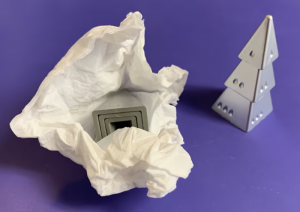 When we got the first samples from our manufacturer, they reported they officially passed the ASTM D3359-17 coating adhesion test. But they also came to us carefully wrapped up in tissue, we guess to keep them extra safe from damage in transit, which didn’t give us a lot of confidence on how strongly adhered to the pyramids that coating really is.
When we got the first samples from our manufacturer, they reported they officially passed the ASTM D3359-17 coating adhesion test. But they also came to us carefully wrapped up in tissue, we guess to keep them extra safe from damage in transit, which didn’t give us a lot of confidence on how strongly adhered to the pyramids that coating really is.
Several tests we did seemed fine. We used tape to try to peel the paint off, we tried to scratch it with our fingers, and we repeatedly stacked the pieces together in our efforts to test the coating. They passed all of these tests with flying colors, and they really are oh so shiny and beautiful… but then we put 3 of the pieces in the box and shook them for several minutes, figuring this would better simulate the actual effect of playing with these pieces.
This shake test, unfortunately, caused the paint at the tip to rub off a bit.
Based on this testing, it would seem that the silver coated pyramids are clearly a bit fragile. They should be fine with careful use, but will almost certainly sustain some wear over time, maybe quite quickly if they are not handled with a bit more care than the rest of your pyramids. The rest of the silver is NOT easily peeling off the piece that had the paint rubbed off the tip, and the gray color of the pyramid underneath makes the missing paint not very noticeable, but if you are expecting no wear, you will be disappointed.
Q: What’s with this sticky residue on the bottoms of the Silver ‘Mids?
A: This is an odd issue we’ve discovered with the silver pyramids: they arrive with sticky feet. Apparently, something about the process they used to apply that silver coating resulted in there being a bit of residue on the undersides of each piece. Fortunately, the gunk rubs off easily enough. We recommend giving the base of each piece a slight buffing against a piece of cloth (the sleeve of a T-shirt works great) then simply using your finger to ball up and remove the lingering bits of residue. Unfortunately, yes, this is a little annoying, and for that we apologize. (See this backer update, Beware the Sticky Residue, for more about that story.)
Q: Why doesn’t this promo card/expansion pack match my deck perfectly?
…It’s not the same [card size, corner radius, thickness, coating, cardstock] as the deck I’m adding it to…
A: We’ve made a lot of card games in the last 25 years, and we’ve worked with a bunch of different printing companies, both in the states and all around the world. We always seek to have new cards match our established standards, in terms of size and corner radius, but sometimes what we get is ever-so-slightly different. Yes, we’ve been known to reject an entire print-run because of the card size being unacceptably, but we’ve also learned to let it go when the tolerances are close enough.
We certainly understand how important it is for extra cards to blend in as seamlessly as possible with the rest of the deck they’ve been added to, but even when the cards are a perfect match, the edges of a new card will be visually noticeable when inserted into a used deck, just because of the differences caused by wear. There’s only so much we can
do.
So, while we’ve made every effort we can to make things match, you might run into a case where they don’t. If that happens, we encourage you to remember that it’s just a game, if you can tell that a certain card is coming up soon, just ignore it. And if it does matter, like if you’re using Fluxx to settle a high stakes score (sure, it could happen) then we recommend using card sleeves.
Q: Is there a good container to fit a double-sized combined Fluxx deck or an UberChrono deck?
A: Why yes, there is! (UberChrono is a little tight, but it works okay.)
Q: What size are the new Zendo pieces, relative to regular pyramids? Would they fit in a Volcano board?
A: The pyramids in the new Zendo set are the size of a medium Icehouse pyramid, and the other Zendo pieces have the expected proportions, in other words the square base shape of all of them is the same size. So they will fit in a Volcano board just fine, but they’ll be a little smaller than the squares, since the Volcano board is designed to hold a large.
Q: What are the differences between the pyramids from different generations, like early ones vs. the later Pyramid Arcade ones?
A: Just before Pyramid Arcade came out Pyramid fans were curious about that newest generation of Looney Pyramids, which would have slightly rounder tips than the two previous manufacturing runs (which were themselves ever so slightly different from each other). Our goal, of course, is for all pyramids to be interchangeable and as otherwise identical to the other versions as possible, but concerns were expressed about stacking new ones onto old ones and having them look funny or something.
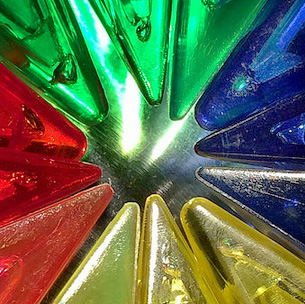 So, Andy put together a test set consisting of four trios from each of the three production runs, with freshly opened pieces of each type, and he carried this set around in one of those awesome round tins he’s so fond of.
So, Andy put together a test set consisting of four trios from each of the three production runs, with freshly opened pieces of each type, and he carried this set around in one of those awesome round tins he’s so fond of.
These were his primary play-testing pyramids for a while, and he spent a lot of time stacking, nesting, and playing actual games using this set, to make sure the three types would all interact smoothly. He was happy to report that they’re great!
He also took a series of photos, which do reveal some slight differences:
For the purposes of this report:
G1 are the first type, made in the USA
G2 are the first set of Chinese-made pyramids, matching the first as closely as possible
G3 are from the newest Pyramid Arcade style, which are more rounded, to comply with EU safety regulations
(You may notice some odd colors in the photos: since he had some, he used G1 pieces with slightly non-standard colors (electric yellows and pinkish reds) to make them more easily distinguishable visually.)
These first three photos show that G1 pyramids do stack taller than the others, but he didn’t find that it mattered — or was even noticeable — in actual play.

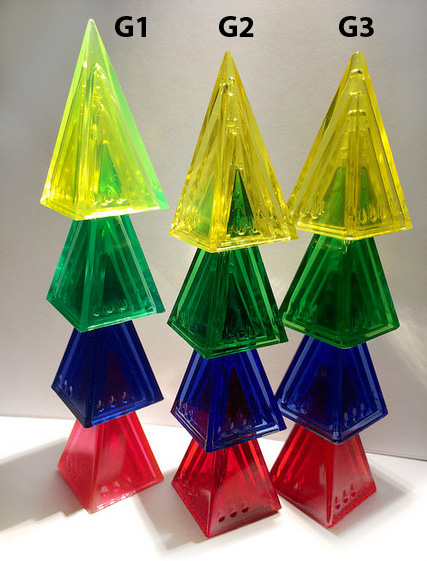
|
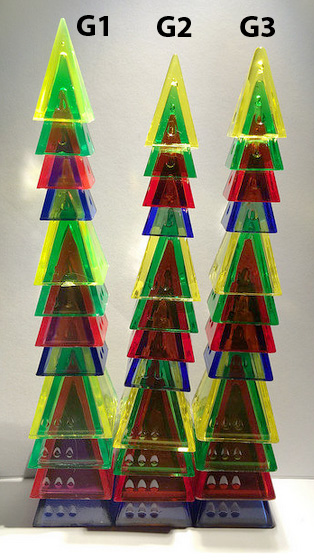
|
The next four photos show the pyramids in mixed trios and stacks. Note that for the stacks of nests shown in the lower right photo, each nest has a mixture of all three generations of pyramids. Again, there are some very slight differences in how they stack, but it’s not something you’d notice, let alone feel is a problem, in actual use.



|

|
This last photo just shows G3 pyramids being stacked up in weird ways that, as you can see, are all still possible.

In closing Andy would like to say that, while he used to worry that rounder-tipped pyramids would feel inferior, once he actually had them in hand, he felt that, not only were they perfectly acceptable, he had to admit they were actually pretty nice. Maybe even better.
Q: What are the dimensions of Looney Pyramids?
A: Here’s an old page for the original specifications from the first time we had them commercially injection-molded. Note that the height is somewhat less for the more recent Pyramid Arcade pieces, since the tips are slightly more rounded. Given that the height is different now, what’s more important to us is probably the angles being correct.
Q: Can I buy your pyramids in custom quantities?
A: No, we don’t sell custom sets of pyramids. The only extra pyramids we have come from product opened due to damage and we use these loose pyramids and other parts exclusively to replace damaged, missing, or lost pyramids to make customers sets whole again.
We do have smaller expansion sets for Pyramid Arcade (Nomids, Ice Duo, Martian Chess, and Homeworlds) for those who want to expand their pyramid collection incrementally, but it’s still the case that we’re not going to want to open those up and mix and match them for people.
If you’re looking to use our pyramids in a game you’re developing, the answer is also NO, see this FAQ for more info:
Can I use your pyramids in my game?
Q: Can I use your pyramids in my game?
A: If you have an existing game from another company, and you wish to use our pyramids as interesting add-ons, substitutes, or accessories, that’s totally fine. We hear about this all the time: people using them as props or puzzle components in RPGs, for example, or subbing them in as counters or game tokens for other games.
If, on the other hand, you’re developing your own game for publication, and you’d like to use our pyramids as part of the game you intend to sell, that’s a hard NO. Our pyramids are custom manufactured for our games. They are Looney Labs items, and we would not want them included in any other product which is not made by, or officially associated with our company, and certainly not in any other product sold by someone else.
Please look into using some other-shaped piece for your games. There are a vast number of companies which produce pawns in all sorts of shapes and sizes. If you need them to stack, that quality is undoubtedly available as well.
You can absolutely use them for prototyping and playtesting game design concepts, but please make sure that the pieces in your eventual actual game are not copies of our pieces. Penguin Soccer is a great example of what you can do. It was designed with pyramids, and even shared with the pyramid community online, and later developed for publication using completely non-pyramidal pieces.
Q: The pegs in don’t stay in well for the original printing of Fluxx: the Board Game. What can I do about that?
Note: With the second printing of Fluxx: the Board Game (in a more compact boxed form) we have fixed the issue with the pegs not staying in (no, not by including little foam feet, something nicer, more like my crafted solution), so this question should be obsolete. I spent a bunch of time crafting this graphic response, however, as well as a lot of time putting these together for any fan who needed some board replaced. So there are a few people out there who have these “deluxe hand-modified by Alison” pegboards in their first-edition giant-box version of F:tBG.
A: Here’s a fun graphic we put together about this:
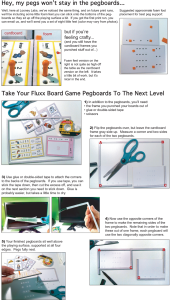
Q: Why are some of your games in hang-tab boxes, and some in two-part lidded boxes?
A: It’s part of our forays into the mass market, vs. the smaller specialty hobby game toy store market. For those games that we feel will work well for the wider audience we use the more common hang-tab style box, which is also slightly cheaper to produce, and allows us to bring prices down for some of the larger retailers who demand lower prices.
Games in this style packaging include:
Get the MacGuffin
Mary Engelbreit Loonacy
Monster Fluxx
Fluxx SE (“Special Edition”)
CN Fluxx (Cartoon Network Fluxx) (out of print)
Q: What can we do about certain card types becoming overworn (Goals in Aquarius, Choice cards in Choose One)?
A: We suggest that you use card sleeves to protect these overused card types. If you’re unfamiliar with these, they are simply custom-sized plastic pockets to put your card in to protect them from wear. People who play games with collectible cards often do this to protect cards they want game with but don’t want to damage for their collectible aspect. Or avid gamers do it for the reasons mentioned here: to protect frequently used game components. You should be able to still shuffle a deck with all cards in sleeves, though it may take some getting used to.
If your cards are already over-worn such that it’s interfering with the secrecy required for game-play, look for card sleeves with opaque backs, or try sliding an extra card of a similar or slightly larger size behind the card in question, so that you only see the extra cardback (regular playing cards would work fine for this, for example, as long as they are close to the same size so that they can fit in the card sleeves you’ve acquired.)
You can find card sleeves for almost any size cards, so search online and see what’s available. You’ll need to know the size of the cards, which you can get by simply taking a ruler to them (though we also list our card sizes here). For a more comprehensive list, however here is one that someone has compiled as a reference on the tabletop gaming reference site BoardGameGeek.com
This informational page (on BoardGameGeek) is incredibly dense, so it starts with a lengthy description of how to read the chart. Then scroll down for a list of games by title. There are pages and pages of them, but you can click to the alphabetic range you need.
Find the game you’re interested in on the list and click the NUMBER to the left (clicking the name gets you to an interesting game description page, but not the card sleeve sizing recommendations). Aquarius is on there, as is Fluxx, but Choose One was not deemed popular enough to include specifically, though the cards should be the same size as Fluxx, which IS certainly on the list.
Although they show two separate lists for first and second edition of Aquarius, to our knowledge, they are exactly the same size. That said, the second edition is more common these days. The Goals have round images, and the deck includes diagonally split cards.
Q: What size are the decks of cards in Pyramid Arcade? Where can I get sleeves for them?
A: There are three different decks in Pyramid Arcade, each a very different size.
The Zark City deck is like a regular deck of playing cards, except that it has five suits and the cards are square. Measurement (roughly, using a ruler) is: 2 & 5/8″ (7 cm) on a side.
The Pyramid Arcade deck, which has a card for each game in the set, has more familiar dimensions. I believe they would be called “poker sized” (wider than “bridge sized”). These are 3 & 7/16″ (8.75 cm) tall by 2 & 15/32″ (6.3 cm) wide.
The Twin Win deck has miniature-sized playing cards which measure 2 & 11/32” (6 cm) tall by 1 & 9/16 (3.95 cm) wide.
BoardGameGeek has an exhaustive listing of card sleeves for a dizzying number of games. Here is the listing for cardsleeve sizes and sources for Pyramid Arcade.
See also: What size are Fluxx cards (or any of your other games?)
Q: Who prints your promo cards, and is it done in the US?
A: Our US printer, DeLano, who prints our larger runs of card games also does most of the packets and expansions. If there are very old packets and expansions in our stock, they might have been done by our previous printer, Carta Mundi. They’re a Belgian company, but they have printing facilities here in the US.
For loose promo cards, smaller runs of packs, and Custom Loonacy, we use a print-on-demand printer called The Game Crafter. In the “olden days” we used a very local printer for the b&w art cards, and I’m sure some of those are still in inventory and being sold in the webstore. They’re almost literally down the street from us.
The peel-off promo-postcards were done by a company called Membership Cards Only. (I know, I know, “But those aren’t membership cards!” Hahahahah!). We no longer make those kinds of promo cards, though they were an interesting way to get out the word about new games.
Q: What size are Fluxx cards? (or any of your other games?) Where can I get sleeves for them?
A: BoardGameGeek has an extensive listing of card sizes for a dizzying number of games. If you go to the bottom of the header, just below the alphabet, and click on the little number indicating how many games are listed, it will give you a drop-down where you can scroll through them alphabetically by name all in one list. Be patient after you click; it’s a long list to generate. “Find” also works within that drop-down, which is nice.
Most of our card games have the same size cards, a slightly narrower type many would call “bridge sized” though that’s not a precise category. The card size (roughly, using a ruler) is 87.5 mm tall by 57 mm wide. (Links below go to the BGG sleeve listing for each game, where available. Where not available, keep in mind all of these games’ cards are very similar in size.)
This is for Fluxx, 2nd edition Aquarius (note there’s only one BGG listing for both editions, so make sure you’re looking at the right one), Chrononauts, Just Desserts, Loonacy (oddly this is Mary Engelbreit Loonacy, because the original isn’t in there, but they all have the same size cards), Time Breaker, Are You The Traitor, Are You a Werewolf. The first printing of Just Desserts (and the expansion packs) were slightly off from this, unfortunately. I could swear Choose One cards are just a hair wider on the short side, but they’re VERY close.
Seven Dragons, old Aquarius, and old Nanofictionary are 88.5 mm tall by 63 mm wide. Current Nano and Aquarius are the same size as Fluxx etc.
Get The MacGuffin cards are: 2.87″ x 4.5″
More info on that in this FAQ.
New standalone Zendo box-set cards are the same size as the Pyramid Arcade deck, which is aaaalllmmost the same size as Seven Dragons cards. But not quite. Note that some of the promo cards for additional pyramid games are not quite the same size. Since these cards are just references, we deemed this an annoying, but not game-stopping issue.
See also: What size are the cards in Pyramid Arcade?
For Tiny Fluxx, you might try the sleeve size listed for the Twin Win cards in Pyramid Arcade (see link above).
If we’ve missed a game card size you’re looking for email us at QA@looneylabs.com
If you FIND said missing game on the BGG list, also please email us, and give us the link, and we’ll add it.
Q: What exactly is in the “Mystery Bag Of Warehouse Swag”?
A: UPDATE: As of Monday Oct 19, 2020, the last of these has been sold, so this answer is obsolete. For those wondering what it was, back in 2013 we had a lot of slower-selling older items, many of which were already being replaced by newer versions, and, to clean up things in our warehouse, we packed them all into this package at a fantastic price. It was such a good price that the shipping price would always seem out of proportion, but that’s just because there was so much in it.
—————-
Q: What’s in the “Mystery Bag Of Warehouse Swag”?
Well if we told everyone that, it wouldn’t be much of a mystery, would it!!!
But seriously, people do ask this, and, given the high shipping cost, we do simply tell people the contents if they ask. We’ll just keep this little FAQ question slightly obscure, by not linking to it. So if you’ve found your way here, and knowing this info makes you happier than you were… good for you!
10 Black Treehouse Die
1 Blue Martian Coaster
1 Yellow Martian Coaster
1 Red Martian Coaster
1 Green Martian Coaster
1 Black Martian Coaster
1 EcoFluxx (first ed.)
1 Fluxx 3.0
1 The Empty City
1 Martian Coasters
1 Fluxx Espanol
1 Pink Hijinks
1 Peace Puzzle
1 Castle Expansion
1 Promo Postcard: Aquarius Dragon
1 Poster: Treehouse
1 Poster: Monty Python Fluxx
1 Poster: Brain No TV
1 Poster: Pirate Fluxx
1 Poster: Looney Pyramids
1 Playmat: Star Fluxx
1 IceDice Playmat
50 Micro Catalog Card
1 Doorway Sticker
1 Mystery Bag of Warehouse Swag Letter
(Yes, this includes loose Martian Coasters AND a packaged game of the same. You will have some extra coasters. They DO work as actual coasters, you know…)
Q: I just bought a new Fluxx, and the cardstock feels really cheap and flimsy! What’s up with that?
* Note that in the past couple of years we have had some games printed/reprinted in China. Different printers = different cardstock. If you’ve been referred to this page, it’s because you were asking about a game, and we determined that it was a Delano print run.
A: It’s true that of our cardstock has changed over the years, as we’ve changed printers and different stocks have been available to us, but for all of our standard playing-card core decks, everything printed at Delano*, our printer in Michigan, has been the same for the last ten years, starting in 2008 with Fluxx 4.0. It’s important that nothing fundamentally change about the cardstock because all of the safety testing needs to hold up from batch to batch. Our printer reports that we use Stoplight black-core 11pt paper.
Here are a few words from our contact at Delano about our current stock:
Most casino cards are around 10.5 to 10.8pt, our stock [at 11pt] is very slightly thicker than that on average.
I’ve been a nerd about the relative density lately. For the thickness of stock we are using, this density is hard to beat. Which means it’s real good stuff. For years I’ve been trying to find either a cheaper same quality alternative for you, or a better quality for the same price. No luck so far. You’d be surprised at how much time has been spent on this project. I’ve even worked with paper scientists to engineer a completely new type of paper. What we are using now still outperformed those efforts.
Just for clarification, 11pt /.011″ is not the relative density. That’s the thickness. The relative density is 302 gsm. While there are things out there with a higher gsm (they just make the card thicker), at the casino card thickness, this has one of the best/highest actual densities out there. I’ve only seen one stock that’s better, but it costs more and we’d have to ship it in from France.
We find that the reason new decks card spin and slide on the table more is because they’re often a little slicker than older, more well-worn cards, not because they weigh a different amount (differences would be infinitesimal for one single card compared to another). They do certainly bend easier than some of those older stocks from back in the day, but we find that they hold up to play just as well.
Given the wealth of information we just got from the printer it seems likely that the relative density they are so excited about doesn’t necessarily make the card stiffer, and the lack of stiffness (increased bendyness) is what’s making the cards seem less substantial. I’ve often wondered whether the cards don’t stiffen with age, but that’s just a personal speculation.
We hope this has all been informative, at the very least. We are sad that you are disappointed with the perceived cardstock quality, but we hope this will not detract from your enjoyment of playing the game itself.
Q: Is there any way to keep those peel-off promo cards from sticking to the other cards?
A: Shane Burton, a fan, wrote in describing this process for cleaning the peel-off promo cards we used to make. When you put them in your deck, they have a lightly tacky front surface and stick to the card in front of them. It takes some effort, but acetone will break up that layer without damaging the card.
Rub on the acetone by dampening a paper towel with it and then rubbing it on the card. You can then see the glue layer start to come up. Then rub a wet (water) paper towel to remove the acetone reside, and then a dry paper towel to get off the water and start removing the glue.
You can see where the glue is by angling the card in the light. Rubbing at it with your thumb can start flaking it away, but most of the time, it takes several rounds of the above procedure to break up all the glue.
It will probably take about three times of going through that process to get all the glue off. He says, “At first I used a card I didn’t mind losing, but I had no issues with the print on the cards. I just went and checked some of them and they still look fine. I cleaned them three or four days ago. They are not perfect shufflers/non-stickers, but they are much, much better.”
We recommend using the acetone outdoors due to the fumes. Acetone can be found with painting supplies in hardware stores. You can also find it in smaller containers at drugstores as nail polish remover, but in that form it’s usually heavily perfumed. It can also be used to remove permanent marker, but despite his concerns, the cards have all come out fine. “Once done, the promo cards shuffle much better and stick much less when cleaned this way. I have probably done eight or ten with no damage to the cards.”
They will start curling to the face side from the dampness, but after you wipe them off the final time, place them on a flat surface beneath a heavy book and let them sit a few hours; they will come out perfectly flat again.
Q: How can I use my printer to make my Fluxx Blanxx come out really nice?
A: Before you go making your own custom cards, be sure to playtest any new ideas well! One fan suggests using one of your blank cards for a playtest by taking a mechanical pencil and lightly writing the text in. If you don’t press very hard, you can erase and reuse the blank. Some people just put a sticky note on the card for playtesting purposes. After all, you don’t want to make all the effort of producing a custom card, only to realize it’s broken.
The easiest way to make custom cards (and the way we do it here at the Labs for prototypes) is to print onto full sheet sticker-paper, cutting the resultant print-out to stick onto the card (Andy recommends Avery 8465 shipping labels with TrueBlock(tm) technology).
You can print directly onto the cards, but note that, depending on what kind of printer you have, the printing may not stick to the card very well, though sealer can help. Here are the various tips for that technique:
For printing directly onto cards, one uses a carrier sheet, which just means creating a layout for your cards in some application, like Word, for example, and printing out a test sheet on regular paper. Then, affix your card/s to the sheet in those spots, using the design to position the card, and run the sheet through again. You can do them one-up, or six-up, or whatever you find works best. Once you get a template for the card placement on the carrier sheet, you can use that same piece of paper over and over, printing from different files with different art in that spot.
For attaching your cards to the sheet, fans have suggested either 3M Temporary Glue Stick, which is kind of like a post-it-note adhesive to coat the design portion of the carrier sheet (rather than the cards), or Scotch removable double-sided tape, which is a similar temporary adhesive. If using the glue stick, note that the cards may still end up with some adhesive on the backs, which sometimes takes a bit of rubbing to remove.
Also note that printing will go most smoothly if you have one of those printers which has an option to feed from the back so that the paper doesn’t have to do much of a bend (this is sometimes available on printers for printing onto thicker cardstock or envelopes). When you’re printing your carrier sheet, use the same feed you’re going to use with the cards on it, so that it will line up the same way.
All sources recommend sealing, either by spraying with fixative for chalk-pastels, or a clear acrylic sealer, matte or gloss.
Then also, of course, keep the resulting cards away from moisture!
Q: Hey, do you still have any more of those tubes that pyramids used to be sold in?
A: We regret to tell you we are long since out of the tubes. We had some left over for quite a while after we switched, and kept them up for sale for folks who liked them, even though we found that they were actually kind of sub-optimal (or years in storage had made them so). They were quite tight in the corners, and the pyramids would stick. Even with all that, and how slowly they sold, we’re completely out of them.

